________________
372
Speculations in the Medical Schools
[CH.
Vaiśeşika school; with that school none of the elements entered into any other, and their qualities were fixed in themselves. However, in spite of these modifications, the relation of NyāyaVaiseṣika with Caraka seems to be close. But the detailed description of the school of Samkhya, in IV. I, as has already been mentioned and explained in the first volume of the present work, in the chapter on Samkhya, does not seem to have much bearing on the needs of Ayur-veda; and so the whole chapter does not appear to fit in with the rest of the work, and it is not referred to in other parts of the book. It is not improbable that this chapter was somehow added to the book from some other treatise.
Suśruta does not, like Caraka, enumerate the categories of the Vaiseṣika, and his account of Samkhya is very faithful to the traditional account given in Isvarakṛṣṇa's Kārikā and in the Samkhya-sutra. Having described the Samkhya theory, Suśruta says that according to medical science the causes of things are sixfold, viz. (1) nature of things (svabhāva), (2) God (Isvara), (3) time (kāla), (4) accidental happenings (yadṛccha), (5) destiny (niyati) and (6) evolution (pariṇāma)1. As Dalhaṇa points out, Suśruta has in several places referred to the operation of all these causes. Thus the formation of the limbs of the body in the foetusstate is said to be due to nature (svabhāva); God as fire is said to operate as the digestive fire in the stomach and to help digestion; time as seasons is said to be the cause of the increase and decrease of dosas; destiny means virtue and vice, and diseases and recovery from them are sometimes attributed to these. Jejjata, in commenting on Suśruta (as reported by Dalhana), says that all the above six causes, with the exception of God, are but different names of prakṛti. Gayī, however, thinks that the above six causes represent the instrumental cause, though prakṛti may still be considered as being the material cause (upādāna-kāraṇa).
As Dalhana and Gayi think, there is no reason to suppose that Suśruta described the Samkhya doctrine; for, immediately after describing the sixfold causes, he speaks of the elements as being constituted of the three gunas, sattva, rajas and tamas. Even the senses are regarded as being material. Souls are according to Ayurveda eternal, though they are limited to their bodies and are not all-pervasive. They are manifested when the semen and the blood combine, and it is this bodily self, suffering transmigration owing 1 Suśruta-samhita, III. I. II.




